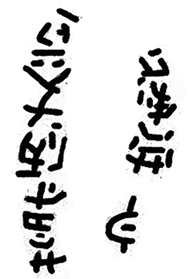Long Edo execution katana blade Tameshigiri 試し斬り test cut on a human body attested Mei
A historical Katana from a turbulent period of Japan with Shirasaya plus original Koshirae solid Gold Habaki
Mutsu Aidzu kyū jū Miyoshi Tōshirō Fujiwara Nagamichi 陸奥会津旧住三好冬獅郎藤原長道 6th Generation famous swordsmith
From the Miyoshi Nagamichi 三好長道 School 伝
Execution of convict attested across the three rows of full detailed cutting test engraved in the Nakago
Cut by the swordsman Gotō Hirasaku 後藤平作
Katana blade:
Cutting Edge 最先端 : 71,6
Nagasa 長さ : 70,5 cm.
Motohaba 元幅 : 3,15 cm
Sakihaba 先幅 : 2,3 cm.
Motogasane 元重 ね : 0,7 cm.
Sakigasane 先重ね : 0,5 cm.
Sori 反り : 2,3 cm.
Age: Last years from the Edo period 江戸時代 (Tokugawa period 徳川時代) during Ansei era 安政
Blade condition: Very good (see detailed description more below)
Polished: Recent, work of a great Togishi 研師 master
Nakago swordsmith signture 署名 Mei: Mutsu Aizu ju Miyoshi Tōshirō Fujiwara Nagamichi
Literal translation and explanation:
- Mutsu (陸奥) Mutsu no kuni is a old Japanese province
- Aizu (会津) location
- Perhaps adition of Kyū (旧) – Old (or previous)
- Ju 住 residence
- Miyoshi (三好) - Miyoshi-shi (三次市) is a city
- Tōshirō (冬獅郎)
- Fujiwara (藤原)
- Nagamichi (長道)
.JPG)
Aizu Domain (会津藩, Aizu-han) was a domain of the Tokugawa Shogunate of Japan during the Edo period.
The Aizu Domain was based at Tsuruga Castle in Mutsu Province
The Battle of Aizu (会津戦争 War of Aizu) was fought in northern Japan from October to November in autumn 1868,
and was part of the Boshin War.
Tameshigiri 試し斬り (test cut on a human body) double line engraved Nakago reverse:
Cut across the upper chest, at the execution ground, 胸上部を横切る
処刑場 Ansei era pass five (year 1858 ) 安政 五歩 Febrero del mismo año 同年二月今眼… by Hirasaku (Heisaku) Gotō 後藤平作
.JPG)
The master swordsman named 後藤平作 (Gotō Hirasaku or Gotohira)
In the last thirty or forty years, two or three pieces tested by this same swordsman have appeared or at least been published. As most of the information in Western countries from Japanese is translated into English, his name appears as Goto Heisaku (the order if you look for it you will often see it incorrectly placed) however in languages of Latin or Germanic origin (which are of similar pronunciation to each other) it would be more correct in my opinion to translate it as Goto Hirasaku even in a study in Japanese the name is self-translated like Gotohira or Gotohei and I have seen this name in very previous studies, let's see an original fragment of the Gotohira other cut test description in a Nakago that I reproduce here exactly: “同三卯年十一月十六日於千住 後藤平作試之”
Gotō = 後藤
Heisaku or Hirasaku = 平作
Gotohira or Gotohei = 後藤平作
Anyway, he is a great master swordsman perfectly located as a member of the Gotō family, a dynasty of experts in cutting, whose activity coincided with the turbulent period of the end of Edo with well-known cases of executions.
Events in which this Katana could have participated and possible reference to the execution related in the cutting test:
The Ansei Purge (安政の大獄);
Ansei no taigoku was a multi-year event during the Bakumatsu period of Japanese history, between 1858 and 1860,[a] during which the Tokugawa shogunate imprisoned, executed, or exiled those who did not support its authority and foreign trade policies.[1] The purge was undertaken by Ii Naosuke in opposition to Imperial Loyalists.
The Ansei Purge was ordered by Ii Naosuke on behalf of the bakufu faction. He was the Senior Minister during the period preceding the Meiji Restoration and was part of the kōbu gattai, the movement opposed by the Revere the Emperor, Expel the Foreigner (sonnō jōi) faction.The purge was carried out in an effort to quell opposition to trade treaties with the United States, Russia, Great Britain, France and the Netherlands, particularly under the U.S. - Japan Treaty of Amity and Commerce. It involved the removal from power all opposition by way of imprisonment, torture or exile, and execution. The crackdown also targeted those who opposed the succession of Tokugawa Iesada and the kōbu gattai or the policy that attempted to unite the imperial court and the shogunateSome of the victims included the sonno joi, the group who opposed Naosuke's appointment of Tokugawa Iemochi over Hitotsubashi Keiki, the candidate of the Mito clan, which was one of the three branches of the Tokugawa family.
Japan descended into chaos after the purge. Elements seeking revenge, particularly radicals from Choshu and sympathizers of the victims launched widespread terrorism. Naosuke was also assassinated by a band of samurai and ronin from Mito.Those who were victimized by the purge reemerged in national politics such as Hitotsubashi Keikei and Matsudaira Shungaku. Attacks against Westerners also increased.
Over hundred influential people were victims of the purge.
Katana blade condition:
The polishing is recent and very well preserved, made in Japan by a Togishi master.
In the excellent polishing, old small defects were solved, and now there is nothing worth mentioning.
The Hamon remains very visible, showing the tonality of the best traditional temper.
You can also see the fine Hada. Thanks to this good polishing, you can clearly see the quality of the
work done by the famous swordsmith who signs this Katana blade.
Very old Shirasaya and Koshirae:
Koshirae look original and from the same Katana blade era. As is well known, ancient Katana that have preserved their original mounts are extremely rare.
As is usual since it is frequently replaced, the silk parts (Ito and Sageo more Same) are more recent than all the rest.
The condition is very good for its much antiquite . The Kodogu of the Koshirae has adequate wear for its age as can be seen in the detailed photos.
It denotes that this extraordinary set of Shirasaya and Koshirae has been very well preserved over the years throughout its entirety.
Shirasaya:
Wood: Honoki (Hinoki 檜 Japanese Cypress)
Also old but from an unknown era. In excellent condition with perfect fit
Wooden sword (Tsunagi) and its Habaki:
Wood: Honoki (Hinoki 檜 Japanese Cypress)
Koshirae:
Tsuka:
Wood: Honoki (Hinoki 檜 Japanese Cypress)
Fuchi/Kashira and Menuki couple: Shakudo with Gold inlay (Fuchi signed)
Same: Genuine Ray Skin
Ito: historical black な黒 natural Silk
(this precise natural very deep tone is another indication of the original age)
Tsuba:
A great fine forged iron work with Gold inlay.
Habaki 鎺:
A great Gold work traditional Habaki for high grade Katanas.
Saya:
Wood: Honoki (Hinoki 檜 Japanese Cypress)
Lacquered: Urushi black ishime
Sageo: Green tones and ivory, embroider of natural Silk
Kojiri: Shakudo
The Fuchi:
Is signed, due to the material and the work we can assure almost without a doubt all the
Kodogu (Fuchi/Kashira, Menukis, Tsuba, Kojiri) is from the same master craftsman who signs.
As is sometimes common in Fuchi (also on Kogatana blades) signatures, it is difficult to read and even more so to interpret, sometimes the craftsman uses a pseudonym or nickname, other times he refers to himself with a text reminiscent of Haiku, other times, as it seems this time, They have a dedication (to the future owner) with the same symbolic/poetic criteria, but all in traditional way...
Fuchi feasible translate:
"Chicken heart"
"To the angry person"
.JPG) 
Koshirae Condition:
The condition of the Koshirae is very good for its age, a slight detachment of lacquer on the Saya of little extent and very localized near Koiguchi, scabbard mouth.
The Kodogu shows superficial wear appropriate to its age.
Two Bukuro 袋 (Katana bag also called because the fonetical translation "Fukuro"):
- One for the Shirasaya made of double silk fine quality fabric purple color with cotton interior lining.
- Another for Koshirae made old craft work quality of pure natural raw silk chrysanthemum theme embroidery, lining
of silk fabric, very good condition despite its age except for one tear (it would need to be sewn) at the end.
According to information from a previous owner, this sword was intended for Hijikata Toshizō 土方 歳三 Fukucho 副長 of the The Shinsengumi 新選組, he resisted the Meiji Restoration and fought against it. The Shinsengumi was the elite group of samurai, commissioned by the bakufu during Japan's Bakumatsu period. There is no way to testify it, but it could be authentic, due to the geographical location and events of the period of this sword reflected in the Nakago texts in signature and cut test.
My opinion about this Katana in shirasaya plus Koshirae:
It is a very rare long Katana blade to find for the following reasons: it is made by a forger of exceptional quality of which not many pieces appear. Being proven at the site of a perfectly marked execution with a complicated cut carried out by a prestigious swordsman of whom many pieces do not appear with his cutting test either. The blade is in excellent condition, with minimal defects corrected in the recent polishing, so its condition is very good. Another unusual rarity is that it retains its original Koshirae in good general condition as detailed in the description.
For these reasons I can issue you our certification (Katanacenter Kantei) numbered (1392). It is also accompanied by the signed and sealed opinion of a collaborating expert in which both the signature and the cut test are declared to be correct and consistent.
If you have any opinion, any suggestion will be welcome, as always. The same as any question that you want to ask me, of course.
Ref.: Katana 133
|



